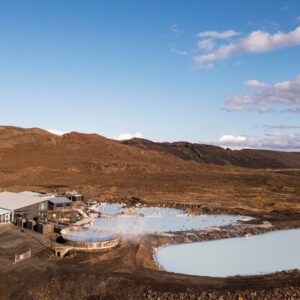Sealing a pond effectively is crucial for maintaining water levels and preventing leaks, ensuring the pond serves its intended purpose. Bentonite clay, a natural and eco-friendly material, is one of the most popular and effective solutions for pond sealing. This article delves into how much bentonite you need to seal a pond, discusses its benefits, application methods, and provides a step-by-step guide for achieving optimal results.
What Is Bentonite Clay?
Bentonite clay is a naturally occurring, absorbent material made primarily of montmorillonite, a type of mineral known for its water-absorbing properties. It swells significantly when wet, forming a gel-like consistency that makes it highly effective at sealing leaks and preventing water seepage.
There are two main types of bentonite clay:
- Sodium Bentonite: Known for its superior swelling capabilities, it is the most common choice for pond sealing.
- Calcium Bentonite: While it has sealing properties, it is less effective than sodium bentonite for this purpose.
How Much Bentonite Is Needed to Seal a Pond?
The amount of bentonite required depends on several factors, including the size of the pond, the type of soil, and the severity of leaks. On average, you may need 0.5 to 1 pound of bentonite per square foot for light leaks and up to 2 pounds per square foot for severe leaks.
Here’s a general guideline:
| Leak Severity | Bentonite Required per Square Foot |
| Light (minor seepage) | 0.5–1 pound |
| Moderate (noticeable) | 1–1.5 pounds |
| Severe (persistent leaks) | 1.5–2 pounds |
To calculate the total amount:
- Measure the pond’s surface area in square feet.
- Multiply the surface area by the recommended amount of bentonite based on the leak severity.
Example:
For a pond with a surface area of 10,000 square feet and moderate leaks:
10,000 sq. ft. × 1.5 lbs/sq. ft. = 15,000 pounds of bentonite clay.
Benefits of Using Bentonite for Sealing Ponds
- Eco-Friendly: Bentonite is a natural, non-toxic material that is safe for aquatic life and plants.
- Cost-Effective: Compared to other sealing methods, bentonite offers an affordable solution.
- Long-Lasting: When applied correctly, bentonite provides a durable seal that can last for years.
- Easy to Apply: It can be applied with minimal technical expertise using various methods.
Methods for Sealing a Pond with Bentonite
There are three main methods for sealing a pond with bentonite:
- The Blanket Method
This method involves spreading a layer of bentonite directly over the pond bed before covering it with soil.
Steps:- Drain the pond completely.
- Level the surface and remove debris.
- Apply a layer of bentonite (1–2 pounds per square foot).
- Cover with 4–6 inches of soil.
- Compact the soil thoroughly.
- Best For: New ponds or ponds that can be fully drained.
- The Mixed Blanket Method
In this method, bentonite is mixed with soil before application.
Steps:- Mix bentonite with the top 6–8 inches of soil in a 1:5 ratio.
- Spread the mixture evenly over the pond bed.
- Compact the area using a roller or similar equipment.
- Best For: Existing ponds with moderate leaks.
- The Sprinkle Method
Ideal for ponds that cannot be drained, this method involves sprinkling bentonite over the water surface.
Steps:- Calculate the amount of bentonite needed based on the surface area.
- Evenly sprinkle bentonite over the pond’s surface, focusing on leak-prone areas.
- Allow the bentonite to settle and absorb water, forming a seal.
- Best For: Small leaks or ponds that cannot be drained.
Factors to Consider When Using Bentonite
- Soil Composition: Bentonite works best in sandy or silty soils. For rocky or highly porous soils, additional preparation may be required.
- Water Depth: Ensure the pond has adequate water depth to prevent drying, which can reduce the effectiveness of the bentonite seal.
- Application Uniformity: Uneven application can lead to incomplete sealing and persistent leaks.
- Compaction: Proper compaction enhances the bonding between bentonite and soil, improving its sealing properties.
Tips for Successful Pond Sealing
- Test the Soil: Conduct a soil test to determine compatibility with bentonite.
- Identify Leak Sources: Inspect the pond thoroughly to identify and prioritize leak-prone areas.
- Use Quality Bentonite: Ensure you purchase high-quality sodium bentonite from a reputable supplier.
- Apply in Dry Weather: For methods requiring soil preparation, choose a dry day to prevent bentonite clumping prematurely.
- Monitor Water Levels: After application, monitor water levels to ensure the seal is effective.
Cost of Sealing a Pond with Bentonite
The cost of sealing a pond with bentonite depends on the quantity required, labor costs, and additional materials. On average, bentonite costs $0.30 to $1 per pound, translating to $300–$1,000 per ton. For a 10,000-square-foot pond needing 1.5 pounds per square foot, the cost of bentonite alone may range from $4,500 to $15,000.
Frequently Asked Questions
- How long does bentonite last as a pond sealant?
When applied correctly, bentonite can last for decades without needing replacement. - Can bentonite be applied to an existing pond with water?
Yes, the sprinkle method allows for application without draining the pond. - Is bentonite safe for fish and plants?
Yes, bentonite is non-toxic and safe for aquatic life and vegetation. - What should I do if leaks persist after applying bentonite?
If leaks persist, consider reapplying bentonite, increasing the dosage, or consulting a professional.
Sealing a pond with bentonite clay is an effective and eco-friendly solution for preventing water loss. By understanding how much bentonite is needed, choosing the appropriate application method, and following best practices, you can ensure your pond remains watertight for years to come.






